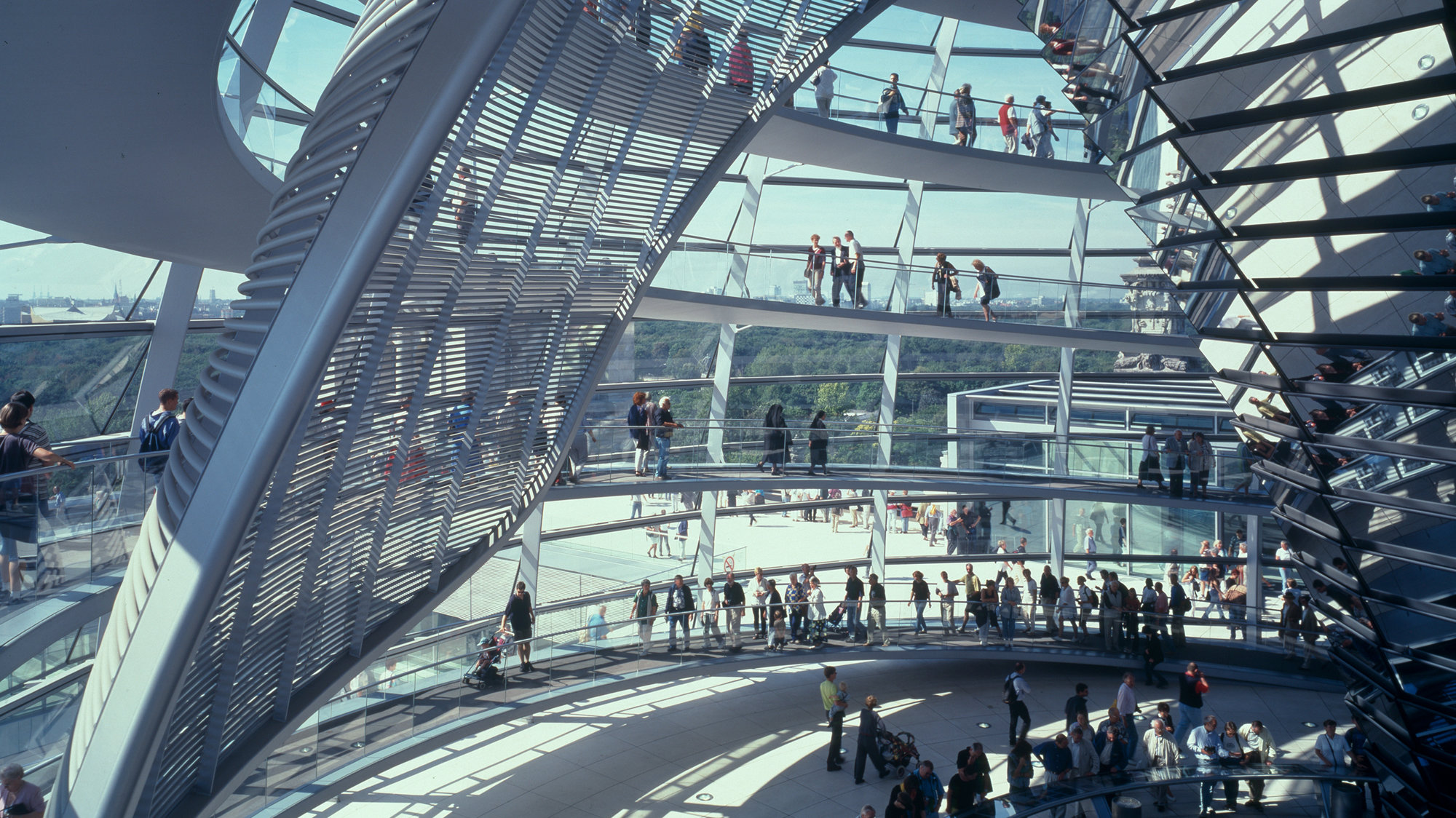The first full plenary session of the Bundestag in the newly converted Reichstag building took place on Monday 19 April.
Foster and Partners' work to transform the Reichstag into the new home of the Bundestag is rooted in four interconnected issues: the significance of the Bundestag as one of the world's great democratic forums; making the process of government more publicly accessible; an understanding of history as a force which shapes buildings as well as the life of nations; and a passionate commitment to the environment-friendly agenda which is fundamental to the architecture of the future.
In 1992 Foster and Partners was one of 14 architectural practices from outside Germany invited to enter the competition to convert the Reichstag into the new home of the Bundestag. In 1993 we were declared winners following a second stage. Reconstruction began in July 1995, immediately after Christo and Jean-Claude's extraordinary cathartic wrapping.
The nineteenth-century Reichstag building had been mutilated by war damage and subsequent rebuilding. The dome had been demolished in the mid-1950s. The facades were restored in the 1960s, but lost much of their ornament in the process. What remained of the historic interiors was disguised with a lining of plasterboard and toxic asbestos, all of which had to be removed.
As we peeled away the layers of history, the bones of the old Reichstag came to light, revealing striking imprints of the past, such as fragments of the nineteenth century mouldings, the marks of masons, infill from the 1960's, the scars of war and the graffiti chalked by Soviet soldiers in 1945. We found that history still resonated through the Reichstag's fabric. We have preserved these memories of the past, allowing the Reichstag to function as a living museum of German history. We have followed a clear ethos of reconciling our new interiors with the old. Junctions between existing and new work are expressed; and where the fabric has been repaired it is articulated, allowing the building's many historic layers to be read clearly.
The reconstructed building takes clues from the clarity of the old Reichstag, reinstating the subtleties of axial door and window alignments. Elsewhere, however, we have departed radically from the original, gouging through the building's many layers to open it up to natural light and views. Glass is used extensively. Within its massive masonry shell the new building is transparent, and all its activities are on view. Public accessibility and procedural openness have guided the design. Significantly, the public and politicians enter the Reichstag as equals, by the same route. We have reopened the original entrance up the grand flight of steps from the west so that people entering the building are confronted with a direct view of the seats of the President of the Bundestag and the Chancellor.
The principal parliamentary level is re-established on the historic first floor - or piano nobile. The second floor provides rooms for the President and Council of Elders, while the third floor houses party meeting rooms and the press lobby which bring life to the building when Parliament is not in session.
On top of these working levels, the public realm reasserts itself on the roof terrace from where visitors have access to a public restaurant and the cupola. Within the cupola twin helical ramps lead to an elevated observation platform that offers unrivalled panoramic views of the city, thus allowing the people to ascend symbolically above the heads of their political representatives.
The cupola was conceived as a 'lantern' with all the associations that term implies. It is a generative element in the internal workings of the building and a key component in our lighting and energy-saving strategies. At its core is a 'light sculptor', a mirrored cone which works like a lighthouse in reverse to reflect horizon light into the chamber. A moveable shield tracks the path of the sun to prevent solar heat and glare.
Germany leads the world in its environmental legislation and from the outset our aim was to demonstrate in the Reichstag the potential for a wholly sustainable public building. We developed a radical solution, using wholly renewable fuels - vegetable oil from date palm, rape or sunflower seeds - which, when burned in a co-generator, is remarkably clean and efficient compared to traditional sources of energy production. This has allowed a 94 per cent reduction in the building's emission of carbon dioxide, far surpassing current regulations.
The Reichstag's energy requirements are sufficiently modest to allow it to perform as a local power station, supplying nearby government buildings. Surplus heat generated by the Reichstag's power plant is stored in a natural aquifer 300 metres below the building. In winter, stored warm water is pumped up to heat the building, or to drive an absorption cooling plant that produces cold water. That too is stored below ground and can be drawn upon in hot weather to provide cooling via chilled ceilings.
In its vision of a public architecture that redresses the ecological balance, providing energy rather than consuming it, lies one of the Reichstag's most intrinsic expressions of optimism. It is optimistic also in another sense. As night falls and the glass bubble of the cupola glows, lit from the chamber below, the building becomes a beacon, signalling the strength and vigour of the German democratic process.
It is surely a sign of a progressive, open society that it can contemplate appointing a foreign architect to build its national parliament building, and then work with him and consultants from around the world to realise that vision. We feel privileged to have taken part in this process, and to have helped the Reichstag to its rebirth.









